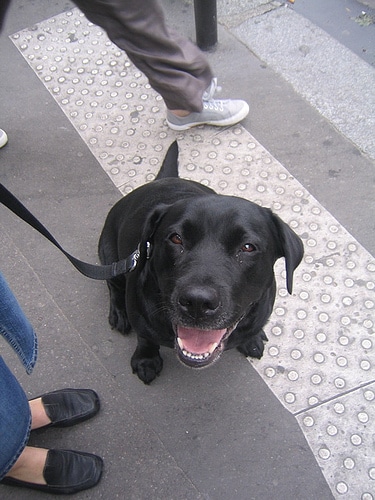Did you know that you can turn a perfectly good dog bad all in the way you interact with them? It’s true. Unfortunately many good dogs get blamed for acting on their pent up frustration which could have been avoided with some proper training, attention, and interaction on the part of their owners.
Frankly, most of the time the owners are the ones to blame for a misbehaving dog, even though they may think they have done nothing wrong. If you aren’t being the leader with your dog, she will try and be the leader of you. Many dogs are not equipped for or even want the leadership role. This is when aggression is fostered and accidents happen.
Some dogs are naturally calm and take life in strides; some dogs let nothing bother them and wouldn’t turn aggressive if their own lives were at stake. Some dogs may seem content to lie around the house doing nothing all day, with absolutely no rules or boundaries. However, dogs are decedents of the wolf, and still have many of the same attributes and needs – such as pack mentality and need for leadership as well as intensive daily exercise and affection only at the proper times. These are the things that will make your dog truly happy.
We all know that small dog down the street that acts like it’s big; you know the one that barks non-stop and tries to take on all the big dogs. Many people think it is funny or cute to see a small dog act this way, thinking it is so tough. However, there is nothing funny about this. While small dogs cannot cause near the damage of large dogs when they attack, the fact still remains that aggressive and uptight dogs, big or small, are unstable and unhappy. Think of it this way: Would you rather feel anxious, nervous, and frightened you entire life, or calm and happy?
Not many dog owners want their dogs to be unhappy, but the fact is you might not understand your dog’s needs.
Table of Contents
The Walk
Many people think that walking their dog is only for the dog to sniff, pull on the leash, and go potty. However, this is simply not true. Dogs long for leadership, and making your dog walk nicely beside you establishes that authority. In a pack in the wild, only one dog is in front (and the front dog varies throughout the day). This establishes order and leadership.
What does it hurt to allow your dog to walk in front of you?
Your dog will most definitely think himself the pack leader and will start behaviors that exhibit such. If you do something he doesn’t like, like pet another dog, or give attention to another person, he will correct that dog or person with aggression. And even if the aggression starts out mild, and doesn’t seem troubling, it WILL escalate eventually.
In the pack, if a dog or wolf steps out of a boundary, she is instantly corrected by the leader. So if you are seeing “correction” behaviors from your dog, be sure that you are not the leader in his eyes, and this could lead to pent up frustration and harbor aggression in your dog.
Also, making your dog walk beside you is mental exercise for your dog and dogs need both mental and physical exercise. Depending on energy level, dogs need as much as two walks of 45 minutes each daily to release their energy. If you don’t have time for this, consider teaching your dog to walk on a treadmill, or run next to you on a bike. These are great ways to release all that energy. But whatever you do, don’t substitute playtime for walking. Again, dogs need to walk beside you and they need to be able to have mental exercise as well as physical.
There is, of course, a time during the walk that you should allow your dog to walk ahead of you and sniff. However, it is important that YOU are the one deciding when he does this. Dog behaviorist Cesar Milan recommends that you allow your dog to sniff as a reward on the walk, only after he is in the right state of mind, and that the reward time should be significantly less than the walk time.
Affection
Your dog simply doesn’t understand you when you tell him, “Don’t be afraid; it’s okay.” and, “Don’t be jealous; I love you too.” But what he does understand is that you are giving him affection and comfort when he is acting outside of your boundaries – which is an encouragement to him to continue the jealous or fearful behavior. Dogs simply aren’t children, as much as we treat them as such, and as much as we want them to be. Children understand your words and they understand you taking away activities and rewards, dogs don’t.
It is easy to give your dog too much affection and one of the hardest things for people to learn is that withholding affection will actually help their dogs more than they know. Of course, when your dog is being calm and obedient, affection is a great reward.
Discipline and Correction
You aren’t going to get very far by telling your dog, “You were bad earlier today, so now you can’t go to the park.” This may sound humorous to you, but many owners treat their dogs this way. Dogs live for right now, and taking away something after they have already forgotten what they have done is not going to work.
Dogs need instant correction, not time-outs like children. Some dogs are more strong-willed than others, but if you set a few basic leadership boundaries, your dog is going to be much easier to handle, and will be much happier too.
1. Never let your dog beg for food
This is not to say that you can’t teach your dog to beg for a treat, but rather that your dog should not sit drooling next to you every time you eat. A good way to teach your dog that begging is not allowed is to make him sit and stay a good distance from you whenever you eat.
2. Teach him some tricks
This should be done after your dog is worn out from exercise, as your dog will be able to focus better. Dogs love to learn new things and use their minds daily. Teaching your dog to track is also a very rewarding experience for both human and canine. Teaching your dog new things can create a good bond and establish leadership.
3. Never let your dog walk in front of you
This applies not only on the walk, but when you enter and exit a room or go out and in doors.
4. Don’t give affection at the wrong time
Unless your dog is calm, affection should not be given. Otherwise, your dog will see you as a weak leader, and most likely become possessive and disobedient. Affection can mean petting, brushing, playing with, and giving treats to name a few.
5. Give your dog enough focused exercise
This is probably the most important of all the tips. You cannot expect your dog to listen to you if you have not first exercised his mind and body.
6. Give your dog a routine
Just like children, dogs thrive on routine. Walk and feed your dog around the same time twice a day. Make her wait patiently for her food and don’t let her approach the bowl until you give her the say so.
7. Make your dog approach you before giving affection
When your dog is in a relaxed state, call him to you and then pet him. Dogs will view you as weak if you approach them for affection.
Of course, most of us don’t want our dogs to be aggressive, and the things we do that make them so are usually out of ignorance. It is a very difficult thing for some people to
realize that dogs’ needs are so much different than children’s. Many people think that giving their dogs rules is just mean and will result in the dog not liking them.
If you are one of these people, do some research into dog training. Every dog trainer out there will tell you to set rules for your dog. Every dog trainer will tell you the importance of teaching your dog to walk nicely on a leash. These are proven methods that work. Your dog will not only respect you, but will be relaxed, happy, and obedient, not to mention bonded with you.
Please train your dog – big or small. It is your responsibility as a dog owner to keep other dogs and people safe from harm that your dog can cause and training him is the best way to do this. Obedience training can do wonders for your dog’s state of mind. And remember – dogs are pack animals, not children!
Photo “Kamila in Paris” copyright of jamtea. *no changes were made to the image


